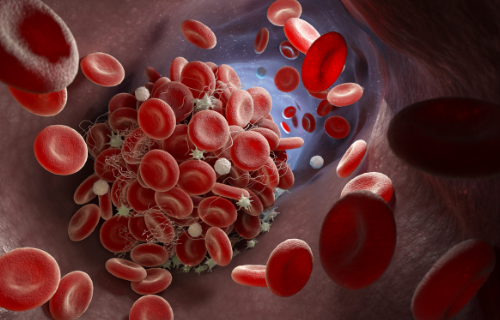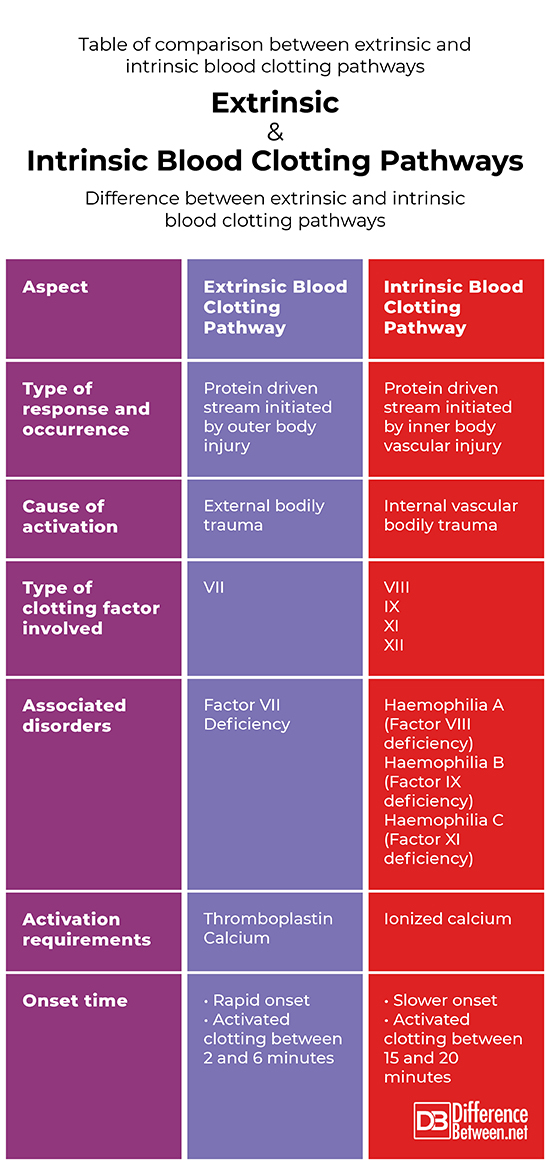Difference Between Extrinsic and Intrinsic Blood Clotting Pathways

Blood clotting is an important response mechanism delivered by the body. When the body undergoes trauma both inside or outside the vascular system, a protein driven process kicks in and a blood clot is formed to stop the bleeding.
There are two pathways which result in the formation of a blood clot. These either occur inside the vascular system or on the outside. Both pathways are equally as important in the fight to stop bleeding in the body.

Follow us as we delve deeper into the differences between extrinsic and intrinsic blood clotting pathways!
Definition
Extrinsic Pathway
The extrinsic blood clotting pathway kicks in when trauma has occurred on the outside surfaces of the body. In other words, external trauma.
Intrinsic Pathway
The intrinsic blood clotting pathway refers to the clotting response to trauma that occurs inside the blood vessels of the body.
Mechanism of Action
Extrinsic Pathway
When external bodily trauma occurs, numerous streams of protein interactions are initiated. For this to successfully take place, calcium and thromboplastin are key requirements.
Initially. the clotting factor III and thromboplastin are activated and result in the clotting formation process. Thromboplastin is present in tissue and under normal circumstances, it does not make contact with blood. However, when injury occurs, thromboplastin interacts with blood and thus activates the process whereby clotting factor VIIa, and phospholipids are converted to clotting factor IX. Lastly, clotting factor X is initiated by Xa found in the extrinsic pathway. This results in blood clotting to at the injured site.
Clot formation via the extrinsic pathway occurs rapidly, taking between two and six minutes to initiate following an external traumatic injury.
Intrinsic Pathway
When internal vascular bodily trauma occurs, numerous streams of protein interactions are initiated. Additionally, platelets become exposed to collagen in the endothelium and aid in initiating the clotting process. For this process to successfully occur, ionized calcium is needed to activate the appropriate clotting factors.
During trauma, foreign surfaces are exposed to the blood. When this occurs, clotting factor XII attached to this, and the intrinsic pathway is activated. Thereafter, factor IX, factor X and factor XI are activated. This then initiates factor II to begin the process of prothrombin to thrombin conversion. The resultant thrombin is responsible for the conversion of fibrinogen to fibrin which then traps platelets in a netted structure and ends as a blood clot.
Intrinsic pathway blood clotting takes a bit longer than extrinsic pathway blood clotting. Following activation, one can expect a response in approximately fifteen to twenty minutes.
Pathophysiology
Extrinsic Pathway
Disorder of the extrinsic pathway is defined as Factor VII Deficiency. This is a genetic disorder and is rare among the general population. It occurs when the human body is unable to produce a sufficient amount of clotting factor VII. Although genetically caused, Factor VII Deficiency can be caused by an underlying medical condition too.
Intrinsic Pathway
Disorders of the intrinsic pathway are classified as:
Haemophilia A (Factor VIII deficiency): the type present in about 80% of intrinsic pathway disorders.
Haemophilia B (Factor IX deficiency): this type is present in about 20% of intrinsic pathway disorders
Haemophilia C (Factor XI deficiency): this type is extremely rare and caused purely by genetics
Table of comparison between extrinsic and intrinsic blood clotting pathways

Summary
When bleeding of the body occurs, blood clotting plays an important role for survival. Trauma, injury and bleeding can occur within the vascular system or on the external areas of the body. Either way, proteins will begin to congregate and interact to proceed with clotting.
There are two main types of pathways in which this occurs. The first is extrinsic pathways and the second is intrinsic.
Extrinsic pathways are activated when bleeding occurs outside the vascular system and requires calcium and interaction between the tissue and blood to intercept. These pathways occur within minutes and are faster. The main clotting factor involved is factor VII.
Intrinsic pathways are activated when bleeding occurs inside the vascular structures and system of the body. They require ionized calcium and interception with collagen to proceed successfully. These pathways are slower than extrinsic pathways, with an onset time of around fifteen minutes. The main clotting factors involved in this clotting pathway are factors VIII, IX, XI and XII.
FAQ
What is the main difference between the extrinsic and intrinsic pathways in the halting of bleeding?
The main difference between extrinsic and intrinsic clotting pathways is that the extrinsic pathways respond to injury or trauma that has occurred on the outer body (externally) and the intrinsic pathways respond to injury or trauma that has occurred on the inside of the body’s vascular system (internally).
Are clotting pathways intrinsic or extrinsic?
Clotting pathways can be either intrinsic or extrinsic. It depends on where the bleeding occurs. If it is on the external areas of the body, then it is extrinsic. If bleeding occurs within the body’s vascular system, then it will activate an intrinsic clotting pathway.
What is the extrinsic pathway of blood clotting?
When external bodily trauma occurs, numerous streams of protein interactions are initiated and flow through the extrinsic pathway.
Initially. the clotting factor III and thromboplastin are activated and result in the clotting formation process. Thromboplastin interacts with blood and thereby activates the process whereby clotting factor VIIa, and phospholipids are converted to clotting factor IX. Lastly, clotting factor X is initiated by Xa found in the extrinsic pathway. This results in blood clotting to at the injured site.
- Difference Between a Cochlear Implant and Normal Hearing - October 4, 2022
- Difference Between Obstructive and Restrictive Spirometry - September 11, 2022
- The Difference Between White Box and Black Box Testing - September 11, 2022
Search DifferenceBetween.net :
Leave a Response
References :
[0]AMOSS. “Hemophilia”. 2022. https://www.amboss.com/us/knowledge/Hemophilia#Z08b4378d313d6ff49266f710b0833e55
[1]AMOSS. “Hemostasis and bleeding disorders”. 2022. https://www.amboss.com/us/knowledge/Hemostasis_and_bleeding_disorders#Zddcded43b9fb0945c6205bbfba7b1004
[2]PEDIAA. 2018. “Difference Between Intrinsic and Extrinsic Pathways in Blood Clotting”. https://pediaa.com/difference-between-intrinsic-and-extrinsic-pathways-in-blood-clotting/
[3]Chaudhry, Raheel., Usama, Syed. & Babiker, Hani. “Physiology, Coagulation Pathways”. StatPearls, 2021. https://www.ncbi.nlm.nih.gov/books/NBK482253/#:~:text=The%20intrinsic%20pathway%20is%20activated,endothelial%20cells%20after%20external%20damage.&text=This%20pathway%20is%20the%20longer%20pathway%20of%20secondary%20hemostasis.
[4]TeachMe Physiology. “Coagulation”. https://teachmephysiology.com/immune-system/haematology/coagulation/
